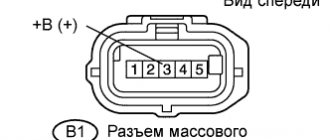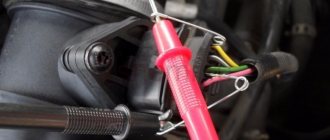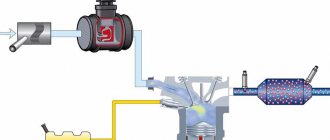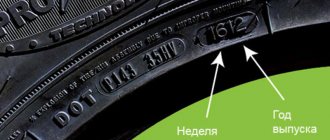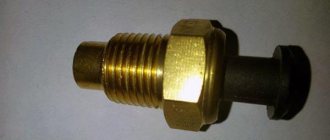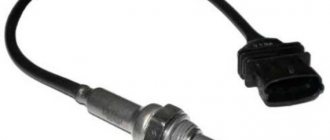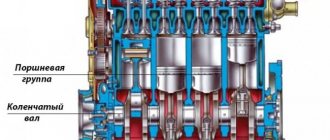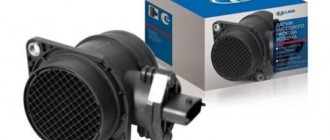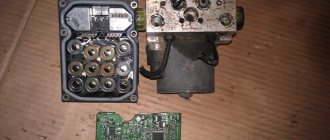In modern cars with injection engines, electronics are responsible for preparing the working mixture. The quality of the working mixture depends on the ratio in which fuel is mixed with air. Depending on the amount of air passing through the throttle valve, the electronic engine control unit determines how much fuel needs to be supplied to the cylinders. To determine the amount of air entering the engine, a mass air flow sensor or mass air flow sensor is used; in some sources the name “volumeter” is found.
“Where is the air flow sensor?” - inexperienced car owners are interested. This sensor is installed in the intake air tract immediately behind the air filter; it is connected to the control unit using a six-pin block.
In theory, the process of measuring the amount of air passing through the throttle valve is not particularly difficult. If you press the gas pedal, the damper opens, and it will be easier for air to get in; when you release it, on the contrary, much less air is sucked in. However, the engine constantly operates in different modes, the driver either presses or releases the gas pedal, and constantly in different ways; in addition, turbulence occurs in the intake tract, so in reality the task will be much more difficult.
Design and principle of operation of the mass air flow sensor
There are no moving parts in the mass air flow sensor. Thanks to this, its service life increases. The principle of its operation is as follows. The sensing element of the first sensors developed by Bosch is a platinum wire or nickel mesh. Electric current is supplied to the element, which heats it. If the system is wire, then the thermoelement will heat up to a temperature 100 degrees higher than the temperature of the incoming air, the temperature of the nickel mesh is 75 degrees higher than the temperature of the incoming air.
The incoming air flow cools the sensing element, therefore, more current is required to maintain its temperature. Based on how much the current has increased, the engine control unit determines how much air enters the engine. Some mass air flow sensors produced frequency output signals, i.e. their variable variable was the frequency of the output pulses. Such mass air flow sensors were used in VAZ car engines equipped with a “January-4.1” controller.
Modern mass air flow sensors, installed, including on VAZ cars, have a more complex design. Instead of wire or mesh, they have a thin film as a sensing element on which temperature sensors and a heating element are placed. The principle of operation of the mass air flow sensor of VAZ cars is slightly different. In the center of the film there is a heating zone; the degree of heating is controlled by thermal sensors. On both sides of the film there are two additional thermal sensors, i.e. one is directly in the path of the air flow, and the second is hidden behind the film. When the car is stationary, the temperature of both sensors is the same; when driving, the first sensor is cooled by the incoming air flow, and the second has an almost constant temperature. The temperature difference between the temperature sensors is directly proportional to the mass of intake air.
How the flow meter works
The first copies of the sensors worked on the principle of a pitot tube in an airplane. The incoming air mechanically deflected the petal connected to a variable resistor. The changing resistance provided approximate information about the intensity of air flow. The technology was subsequently improved, and today the vast majority of cars have thermal anemometric sensors.
Regardless of the car brand, they look approximately the same.
The housing is a hollow cylinder, the diameter of which corresponds to the air duct of the intake manifold. It contains an electronic group consisting of various sensors and a heating device. An electronic control and data reading circuit is made in a single housing.
- Two resistors in series are connected in a bridge circuit and should show the same resistance. One of them is variable, the second is reference. A variable resistor is made of platinum wire and changes resistance as the temperature changes.
- To synchronize with the reference, the wire is heated until the resistance values match. When blown with air flow, the platinum wire cools and the resistance changes. The resistor heats up (at the command of the control unit), for this purpose a certain voltage is applied to the contacts.
- The value of this voltage is recorded by the engine ECU controller with an accuracy of 1/1000 volt, and based on a calibration graph, it converts the data into air volume.
Which mass air flow sensor is better
Each sensor has its own advantages and disadvantages, so this question cannot be answered unambiguously. The wire mass air flow sensor is highly reliable. This is its main advantage, which can cover all the disadvantages, including lower measurement accuracy compared to film mass air flow sensors and the inability to register reverse air flow.
The film sensor, which is installed on modern VAZ engines, due to the presence of two temperature sensors, is capable of registering reverse air flow (if the temperature of the second sensor is lower than the first), in addition, the accuracy of its measurements is very high. The main disadvantage of the sensor is that it is afraid of dirt and moisture, so if the car owner wants uninterrupted operation of the sensor, he needs to carefully monitor the condition of the air filter.
Interchangeability of mass air flow sensor for VAZ cars
Some owners of VAZ cars are interested in what will happen if they install another mass air flow sensor instead of the standard one, and how safe such an improvement is.
Still, if absolutely necessary, if the standard sensor cannot be found anywhere, you can “reflash” it to the parameters of the mass air flow sensor intended for another VAZ engine. However, this should be done extremely carefully, since there is a high probability of completely destroying the ECU. » alt=»»>
All modern engines are equipped with a mass air flow sensor (mass air flow sensor). This sensor is necessary for the normal operation of the car. Signs of a malfunction of the mass air flow sensor appear in unstable engine operation , as the fuel mixture is not formed correctly. You cannot drive a car with a non-working sensor; this can lead to other, more serious damage.
The principle of operation of the mass air flow sensor
Mass air flow sensor design
The mass air flow sensor is responsible for ensuring that the fuel mixture is correctly formed based on the amount of air consumed.
The mass air flow sensor is responsible for ensuring that the fuel mixture is correctly formed based on the amount of air consumed. It determines how much gasoline should enter the cylinders of the block through the injectors, sending appropriate signals to the electronic control unit . In order to determine the amount of air that passes to the throttle valve, highly sensitive threads are built into the sensor. The mass air flow sensor is located immediately behind the air filter, and determines the amount of air already purified. Mass air flow sensor is installed on all modern gasoline and diesel engines. In older engines without a mass air flow sensor, the fuel mixture is formed based only on the throttle position . That is, the harder the driver presses the accelerator pedal, the richer the mixture. This does not take into account air quality and density, and the engine does not always operate optimally when temperature or other environmental factors change.
How to comply with consumption standards
The dosage of the liquid component is easy to ensure. The pressure, the diameter of the gas line, and the throughput of the fuel injectors are known. By opening the injector valve for a certain time, the ECU controller can fill the combustion chamber of the cylinder with exactly as much gasoline as is required to form the mixture. How to measure the mass of incoming air?
To generate data on the amount of air, injection cars are equipped with a mass flow sensor. It converts information from physical (kg/hour) to electronic, in the form of varying voltage at the sensor output. There are even special calibration schedules for the engine ECU.
A certain mass of air passing through the mass air flow sensor corresponds to a clearly established voltage value, accurate to 1/1000 volts.
Having received additional information:
- air temperature;
- the presence of oxygen in it;
- engine temperature;
- data from lambda probes;
- speed from crankshaft sensor;
The electronic control unit mixes the optimal proportion of the fuel mixture in the combustion chambers of the cylinders.
Since the air sensor generates a continuous stream of data, the mixture composition is adjusted in real time, ensuring acceptable fuel consumption for the vehicle. In addition, based on this data, the ECU complies with exhaust gas toxicity standards in accordance with the Euro environmental standard for a particular vehicle.
Many fans of power plant tuning are wondering: is it possible to drive without a mass air flow sensor? There is a misconception that this device is intended solely for the environment, and turning it off will increase the power of the car. To get the correct answer to this question, let’s look at the mass air flow sensor device.
Causes of DMRV malfunction
MAF sensor location
Most often, the mass air flow sensor does not work correctly due to clogging.
- Clogging. Most often, the mass air flow sensor does not work correctly due to clogging. Crankcase gases from the throttle valve, or propane gas when connected to the throttle valve block (Euro-2), can get here along with the air. As a result, a layer of deposits forms on the threads that sense the amount of air.
- Broken threads. Sensor threads can fail due to wear or misuse. Like any other device, the mass air flow sensor has a limited service life, and, as a rule, it lasts for 100-150 thousand mileage. In addition, the sensor may break due to gas detonation in the throttle assembly.
The main symptoms of a malfunction of the mass air flow sensor
- The engine runs rough at idle. If the sensor is faulty, the idle speed of the car will be unstable. Especially when starting the engine before warming up, there will be strong fluctuations in speed. Sometimes the engine simply stalls if you increase the speed with the accelerator pedal.
- RPM freezes. Also, the revolutions can hang at around 2-3 thousand when the gas is completely released and stay there for several seconds.
- Lost engine thrust. If a faulty sensor leans the mixture, the engine power will decrease. The car will accelerate poorly and go downhill.
- Increased fuel consumption. A low signal from the mass air flow sensor can cause the mixture to be too rich, resulting in a 20-30% increase in flow.
Diagnostics of mass air flow sensor
When you turn off the mass air flow sensor, you can deceive the ECU - it switches to emergency mode using a simplified algorithm.
Before you begin repair work, you need to find out whether the problem is really in the mass flow sensor. You can check the mass air flow sensor yourself even without instruments. To do this, you simply need to turn off this sensor with the engine off. Then the operation of the car without the sensor is checked. If the problems disappear, then in this case the sensor is faulty. When the mass air flow sensor is turned off, the control unit can be deceived, and it switches to emergency mode and operates according to a simplified algorithm. But it is not recommended to constantly use a car with the mass air flow sensor turned off. In this case, fuel consumption increases and the engine does not work quite correctly. You can also check the mass air flow sensor with a multimeter. In order to ring the air flow sensor, you need to connect the probes to the sensor while the engine is running. The device should show 1-1.02 volts. If the voltage on the sensor is more than 1.05 volts, then the sensor is faulty and does not work correctly. It is advisable to clean it or replace it. The pinout of the mass air flow sensor is described in the instructions for the car, since different cars have different connectors for connection. You can also check the performance of the mass air flow sensor by reading errors from the on-board computer. A faulty sensor necessarily transmits an error message to the control unit. Before checking the mass air flow sensor, it is advisable to rule out other potential problems. Similar problems with lean or over-rich mixtures can be caused by the throttle position sensor, idle air control valve and lambda probe.
Video “Checking the mass air flow sensor using a multimeter”
This video from the “Simple Opinion” channel demonstrates how to check the mass air flow sensor with a multimeter.
Help me figure out if the DMRV malfunctions, immediately change the DMRV or clean it. And how to check the DMRV. and how did your car behave with a faulty air sensor and after replacing it?
Comments 11
But when I turn off the mass air flow sensor, the car stalls, is that how it should be?
Soak it in gasoline overnight. It helped me when carb cleaner didn’t help!
I turned off the DMRV today, nothing has changed
That means it’s not a matter of the mass air flow sensor!
It’s just that the diagnostics already show that the DMRV has been screwed up and the control unit is blocked; it’s already in emergency mode. I don’t have a check on my car. I have an EPS (control of engine electronics). I think I’ll probably buy a new one.
YOU CAN check! turn it off and that's it! The car will start working in an “emergency” state, the “check” will light up! and try to ride! Good luck!
The spark plugs are blown, when you give it gas, there is black smoke at rpm. As they say, the consumption increases
first, of course, try to clean it, it’s cheaper than changing it right away, if that doesn’t help, then of course replace it. Symptoms of a dead sensor can be either separately, but more often all together - it becomes dull when accelerating, eats gasoline in buckets (for 1.6 liters 12-13 probably), the smell of gasoline from the exhaust pipe when the engine is running, black carbon deposits on the spark plugs. In general, if the computer says that there is a weak signal from the DMRV, then it is half-dead, but it can be brought back to life) regarding cleaning - I would not recommend cleaning it with carbkiner, it is a very active mixture. although people cleaned it, it seemed without consequences, at least at first)) (certain types of air flow sensors, tape ones definitely cannot be cleaned) I cleaned mine like this - I warmed up a glass of alcohol in the microwave, lowered the sensor there to let it dry (this three or four times), then I very carefully cleaned those very sensitive elements with a pen and alcohol. I took photos before and after the event - the difference is noticeable, and this difference was visible only during macro photography and when viewing the photo on a 16x zoom)) after cleaning, the smallest wire on the sensitive elements became visible.
Replacing the air flow sensor
If the mass air flow sensor is faulty and cannot be cleaned, it must be replaced with a new one. Depending on the car model, the price of a mass air flow sensor is 3-5 thousand rubles.
- Disconnect battery. In order not to damage the power supply circuit, it is advisable to carry out all procedures with the battery disconnected.
- Remove the old sensor. First, the plug with the wiring is disconnected, then the fastener is unscrewed and the sensor is removed from the air duct.
- Install a new sensor. The new sensor must be installed carefully, without touching the threads inside the sensor. Then the plug with wires is connected. The sensors have a standard connector for each car brand.
- Connect the battery.
What happens if you turn off the air sensor of the VAZ 2110
- To the beginning of the forum
- Forum Rules
- Old design
- FAQ
- Search
- Users
It is worth killing the one who invented the mass air flow sensor. Kill. Resurrect. Kill again. Then torture.
PS. I don't think anyone turned it off. Either exchange it for Siemens or all sorts of dadas, or buy a new one and pray that it will last for more than 10 thousand
You can still wash it when you have nothing to lose.
there are 2 rows of numbers stamped on it, and you need to take t
where did you see two rows of numbers? what's on the box?
How to clean the mass air flow sensor
It is not possible to repair the mass air flow sensor with your own hands, since the threads inside the sensor cannot be replaced.
It is not possible to repair the mass air flow sensor with your own hands, since the threads inside the sensor cannot be replaced. Therefore, you can only replace it with a new one or try to clean it. The air flow sensor is quite expensive, so it is advisable to try washing the threads. In half of the cases, this helps and after using the mass air flow sensor cleaner, the engine starts working normally. Under no circumstances should you use aggressive solutions to clean the sensor. If you apply acetone or carbocleaner, the threads will most likely be damaged and the sensor cannot be restored. It is advisable to use Liqui Moly air flow sensor cleaner. Also a fairly high-quality product is the Luftmassensensor Reiniger air flow sensor cleaner. Among folk remedies, formic alcohol is often used. To clean, the sensor must be carefully removed without touching the threads. Then a cleaner is applied to the threads inside. The liquid is applied several times at intervals of half an hour so that all deposits can dissolve. After washing, the sensor dries and is installed in the car. Do not use a hair dryer or other devices for drying. DMRV is one of the most important sensors in a car, as it is responsible for the formation of the fuel mixture and normal engine operation. If it breaks down, engine performance deteriorates and consumption increases greatly. Therefore, it is advisable not to delay repairs and replace or clean the sensor as quickly as possible.
With the advent of electronic processor devices and injection systems for forming an air-fuel mixture into the internal combustion engine control system, it was necessary to use special sensors that determine the parameters of the mass flow in the intake manifold. The first was the mass air flow sensor.
Calm, just calm!
Don't worry so much in advance.
Perhaps the reason for your troubles is quite simple and prosaic, easy to correct and repair “without leaving the cash register.” Therefore, we go into the garage, turn off the car, inhale deeply, exhale slowly (several times, to be sure), change into work clothes (if you are not used to getting dirty, put on gloves), and - go ahead! Yes, and at the beginning of your repair work, analyze the behavior of the car: the car’s reaction to attempts to start. What did the battery say? Does the starter turn? Does the engine “snatch” or “sneeze”? All this is important to understand the causes of troubles.
{banner_content}
What is a mass air flow sensor in a car?
The controller that controls the amount of fuel injected by the injector must receive information about the mass flow moving through the intake manifold. For this purpose, the readings of the mass air flow sensor are used - a device for fixing the mass air flow. The more accurate the information, the better the mixture.
The reason to get acquainted with the “hardware” of the mass air flow sensor and its location in the engine appears at the first symptoms of a malfunction of the mass air flow sensor. The reasons may be:
- unstable engine operation, both at idle speed and when driving on the highway;
- the engine starts with great difficulty, especially if it was previously running under load;
- the appearance of an indication on the dashboard indicating problems with the engine, and fuel consumption increased noticeably.
Design and operation of the air flow sensor (AFS)
Considering the fact that AvtoVAZ generously stuck mass air flow sensors on all more or less hard-working cars, from the tenth to the fourteenth model, it is worth knowing how this miracle works and works.
The principle of operation of the mass air flow sensor uses a change in the temperature of a 0.07 mm metal layer welded onto the ceramic layer of the sensor, or a thin platinum wire under the influence of an air flow. The mass air flow sensor is installed on a special holder and placed in the central part of the air manifold section in front of the throttle valve to reduce the influence of local turbulence.
In addition to the platinum layer, two thermistors are glued to the surface of the silicon element to record the temperatures of the air and the sensitive element. A small electrical circuit controls the measurement process, and under certain conditions it also starts a self-cleaning mode of the sensor from varnish and oil films of dirt. At the same time, on the surface of platinum the temperature soars to 1000 o C, and oxygen in the air converts organic substances into combustion products.
We check and evaluate the symptoms of a DMRV malfunction
It is clear that signs of a malfunction are conditional, problems may not be limited to the performance of the mass flow measurement device, so before deciding on further procedures it is worth conducting a couple of additional tests to diagnose the mass air flow sensor.
To do this you can do:
- driving with the mass flow sensor disabled;
- measuring the potential of the mass air flow sensor;
- An old military trick is to temporarily replace the problematic sensor with a known-good mass air flow sensor, rented from a gullible neighbor.
If you are not the proud owner of an ECU controller Ya7.2.M7.9.7., simply disconnect the connector block on the air flow sensor. With another type of engine, fault testing will not work. What happens if you disconnect the mass air flow sensor (MAF)? The engine will start and run. In this case, the logic of the controller, which has detected a complete malfunction of the air flow sensor due to a removed contact, will switch it to emergency mode based on information about air flow and will use its average values and information about the throttle position.
In practice, this will mean increasing the idle speed to 1400 rpm, depending on the deadness of the throttle position sensor. Most importantly, in the sensations during control acceleration, you will feel that the agility and throttle response of the car has noticeably increased. Conclusion: most likely the mass air flow sensor is bad, but the question is - how bad? The main idea of the check is not to rush to buy and replace an expensive mass air flow sensor, but to try to find a compromise. It is possible that by washing or other manipulations the operation of the mass air flow sensor can be restored.
Is it allowed to travel?
You can drive without a mass air flow sensor - yes, but you should carefully assess the situation. When devices fail, the driver does not always have a spare one with him in his emergency kit. Also, sensors for some types of cars are extremely difficult to find, especially when it comes to brands of foreign cars.
In the event of a planned or emergency shutdown of the device, the vehicle operates in emergency mode. Only the throttle valve is responsible for preparing the air-fuel mixture. The state of affairs cannot be called correct, since it provides ideal performance indicators, quickly breaks down and leads to breakdown of the constitutive parts of the mechanism. What will happen if you drive without a mass air flow sensor for a long time, it is clear that the car will become unusable.
When operating in emergency mode, only the damper determines fuel consumption. There is high fuel consumption. There will be no fuel savings, which is extremely unprofitable in Russian realities. The crankshaft rotation speed will be at least half a thousand revolutions per minute. There are no gradations.
You can determine whether the sensor needs to be replaced yourself. To do this, the device is turned off and only the throttle valve reads the readings. If, in the absence of equipment, the vehicle moves quickly, then it is faulty and requires replacement.
Measuring the potential on the mass air flow sensor
If your car has a Bosch version of the flow sensor with catalog designations 0280218004, -037, -116, it is easier and more reliable to directly measure the potential generated by the mass air flow sensor DMRV. We measure using any device that allows you to work with a range of 0-2 V and an accuracy of at least a hundredth of a volt. Try to use a proven device for measurements, without additional extension cords, wires and needles.
Finding the mass air flow sensor housing in the air manifold is quite simple. A wire harness of different colors fits into the connector chip, tightly closed with a rubber cap. The MAF pinouts include the following:
- The 1st wire provides the sensor input signal, usually a yellow wire;
- The 2nd and 3rd wires are responsible for the power supply, “+” and “-”, respectively;
- The 4th wire is connected to the main relay.
To measure the potential, we use the first and third wires of the harness. There are several options for connecting the probes of a measuring device, but you should definitely not use paper clips or thin sharp wires. They can significantly affect the accuracy of the measurement. You can finely sharpen the copper tips of the probes and pierce the insulation of the wires with them, as close to the contacts as possible.
The measurement is performed with the ignition switch on but the engine turned off. If the connection is made correctly, the device will show a value from 0.996 - for a new sensor, to 1.05 - for one that is practically “dead” and requires replacement.
What happens if you turn off the air sensor of the VAZ 2110
There will be: 1. Higher consumption. 2.Higher revs XX. 3.Accordingly accelerated engine wear. 4. The engine will not produce the required horses and torque.
and with DMRV? . it seems like XX with air flow sensor should be like this, but without it = about 2000
Quote: There will be: 1. Higher consumption. 2.Higher revs XX. 3.Accordingly accelerated engine wear. 4. The engine will not produce the required horses and torque.
patap48
If you carefully read my topic, then I myself challenged it there))))))))) because it became better. but I did not receive a clear answer.
PySy since the mass air flow sensor had to be changed, I washed it. The month is already plowing. ugh ugh ugh
I didn’t get a clear answer
and with DMRV? . it seems like XX with air flow sensor should be like this, but without it = about 2000
Quote: There will be: 1. Higher consumption. 2.Higher revs XX. 3.Accordingly accelerated engine wear. 4. The engine will not produce the required horses and torque.
Is there any marking there? Which one should I buy?
For fuck's sake, did you speed up the car? However, it is fraught.
037 is easily placed instead of 004. But for 116th you need to change the calibration in the firmware.
It’s like this: if I’m wrong, people will correct me.
patap, since the DMRV is to be thrown away, for the sake of science, wash it))))) we are just interested in whether it makes sense or not. but few people wash it, everyone buys a new one
037 is easily placed instead of 004.
Assessment of the condition of the air flow sensor by external inspection
To remove the sensor, you need to unscrew its mount on the air duct, loosen the clamp and disconnect the corrugated piece of pipe. The sensor itself is fastened with a pair of screws that can be unscrewed with a ten key, after removing the chip with wires, you can carefully remove the housing from the socket. Inspecting the surface, you can see traces of dust and oil. The presence of stains and dirt suggests that the self-cleaning mode will no longer help it. But we need to find the cause of the pollution.
Pay attention to the rubber ring sealing the connector. It performs the function of blocking possible suction from the engine compartment into the sensor cavity of dirty air clogged with fumes. In the normal position of the suction ring, most likely there was no suction.
Most often, dirt settles on the surface of the sensor due to poor condition of the air filter. Sometimes, on the recommendation of numerous experts, car enthusiasts treat the filter cartridge with a special oil aerosol. Typically, this preparation is used on full-flow air filters of zero resistance. But the effect is achieved for a new filter within the same 5-10 thousand km. The aerosol will not provide special protection for the mass air flow sensor from microdust particles.
The video shows a little more about the mass fuel flow sensor:
